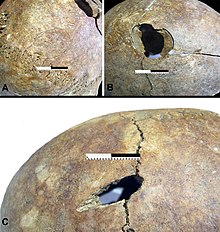Potočani massacre
When massacre Potočani were before about 6200 years ago in the middle Eneolithic 41 people by blunt force killed. Their corpses were deposited in a mass grave in the area of today's Velika municipality in the Požega-Slavonia County of Croatia without the burial ritual that was customary at the time (burial in a crouched position with grave goods ) .
Discovery of the massacre
In the course of an emergency excavation on the site of the Velika village Potočani , a small pit about 2 × 2 meters and a depth of one meter was discovered in 2007; originally the pit was probably deeper. The pit had been dug into soil that was otherwise undisturbed by cultural influences and contained the remains of at least 41 people. The arrangement of the preserved bones led the archaeologists to conclude that the corpses were deposited in a great hurry and in a disorderly manner without grave goods. The pit was then filled with clay, which also contained a small number of pottery fragments and animal bones. The dating of the bones using the radiocarbon method showed an age of around 6200 years ( cal BP ).
Investigation of the finds
Already when uncovering the finds, the archaeologists noticed that the bones of the individual skeletons mostly had the usual arrangement for the living, that adults as well as children and adolescents were among the dead and that numerous skulls showed clear signs of significant injuries from hard blows . The arrangement of the skeletons and their dating suggested to the archaeologists the interpretation that the dead were not buried in the course of a lengthy event, but that they were the victims of a single violent incident, which the archaeologists described as a massacre .
In 2017, the damage to four skulls was described in detail in a study. Accordingly, these skulls were shattered on their right half by several massive blows. The injuries to the skull bones were caused partly by sharp and partly flat tools. This resulted in cuts , holes and broken debris , which were probably caused by several attackers, each with different weapons. The position of the damage - mostly on the right side of the back of the head - was interpreted as typical for a right-handed person striking behind the person and therefore as evidence of an execution. Nine other skulls showed comparable damage; these 13 skulls were from six children, three men and four women. The bones of the body below the skull, however, did not reveal any injuries, which was interpreted as a further indication that the dead were victims of a massacre rather than a combat operation.
In a paleogenetic study in 2021, inter alia reports the family relationship between the dead. The researchers succeeded in determining DNA residues for 38 of the 41 killed . According to their analyzes, those killed - 20 female, 18 male - came from a genetically homogeneous, but at the same time genetically diverse population of Neolithic farmers that was widespread in what is now Croatia and elsewhere in Eastern Europe. Specifically, those killed were two children aged 2–5 years, nine children aged 6–10 years and ten adolescents aged 11–17 years, as well as 14 young adults aged 18–35 Years, five adults aged 36–50 years and one adult whose age could not be accurately determined. 27 of the 38 individuals were not closely related to any of the other victims, but a family relationship could be proven for 11 persons. This was
- a young man and his two 6–10 and 11–17 year old daughters as well as the 6–10 year old son of his brother,
- two 6-10 year old girls (siblings) and their 3rd degree relatives (a young man),
- a middle-aged man and his 11-17 year old son,
- a 6-10 year old boy and a young woman (the boy's half-sister - same father, different mother - or a paternal aunt).
These findings were taken as confirmation of earlier interpretations that the dead were not victims of fighting, in which at the time mainly young men were involved. Rather, the authors of the study saw similarities with the Talheim massacre , the Schletz massacre and the Kilianstädten massacre (which were committed 7,000 years ago) and the Koszyce massacre , which was committed 5,000 years ago.
The causes of the Potočani massacre are unclear. However, a study on the diet of the victims published in 2020 reported that evidence of malnutrition was found in the younger children that was not evident in the older children. This could mean that living conditions in the Balkans were deteriorating at the time, which made violence and conflicts more likely.
Web links
- 41 skeletons testify to indiscriminate mass murder in the Copper Age. University of Vienna, March 11, 2021.
supporting documents
- ↑ a b Mario Novak et al .: Genome-wide analysis of nearly all the victims of a 6200 year old massacre. In: PLoS ONE. Volume 16, No. 2, 2021, e0247332, doi: 10.1371 / journal.pone.0247332 .
- ↑ a b Sarah B. McClure et al .: Paleodiet and health in a mass burial population: The stable carbon and nitrogen isotopes from Potočani, a 6200 ‐ year ‐ old massacre site in Croatia. In: International Journal of Osteoarchaeology. Volume 30, No. 4, 2020, pp. 507-518, doi: 10.1002 / oa.2878 , full text .
- ↑ a b Ivor Janković et al .: Prehistoric massacre revealed. Perimortem cranial trauma from Potočani, Croatia. In: Anthropologischer Anzeiger. Volume 74, No. 2, 2017, pp. 131–141, doi: 10.1127 / anthranz / 2017/0688 , full text .
- ↑ Mysterious Massacre in the Copper Age. On: scinexx.de from March 15, 2021.
Coordinates: 45 ° 38 ′ 28 ″ N , 17 ° 23 ′ 27 ″ E

